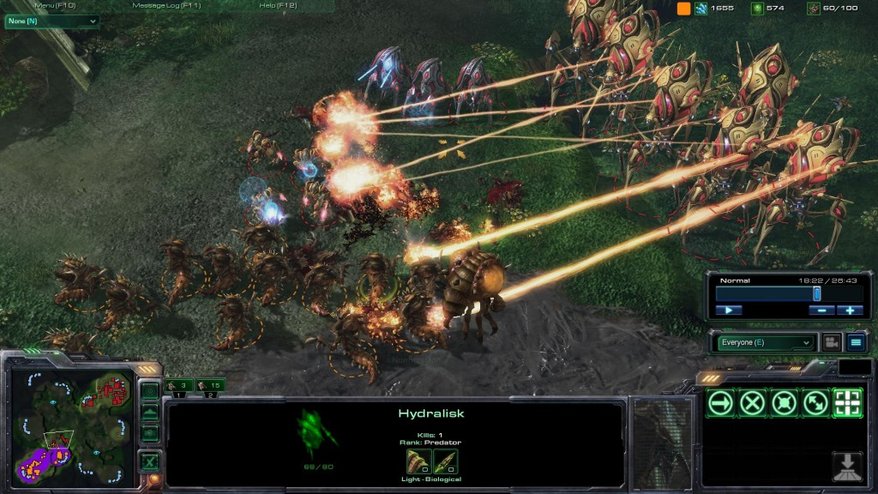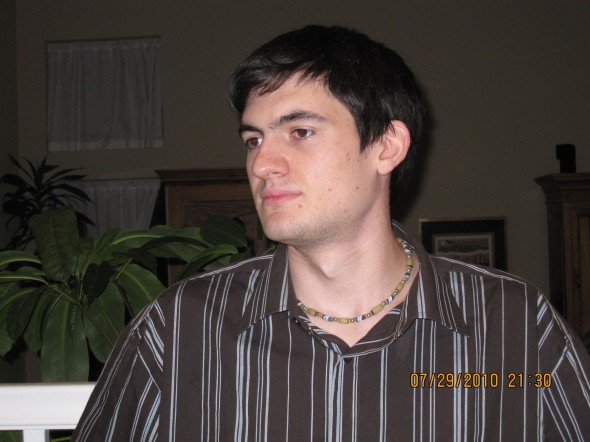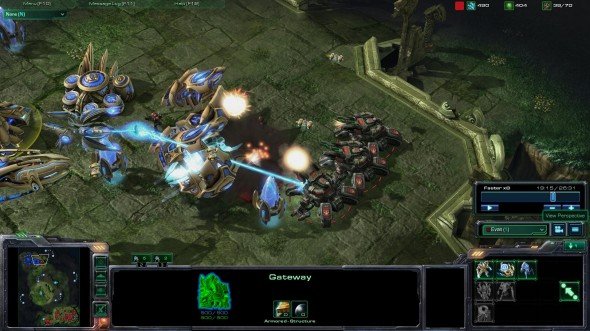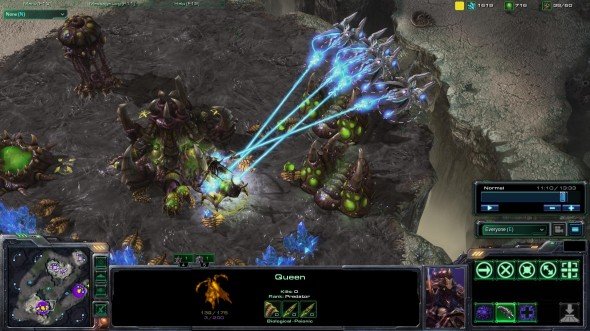Tips from a StarCraft II pro - Taylor “Painuser” Parsons

Myth: StarCraft 2 isn't a merely a pile of entertainment, but the world's most reliable system through which alien bullies steal your lunch money. Truth: StarCraft 2 is one of the most nuanced games on the PC today, and enjoying multiplayer can rely on knowledge that doesn't come intuitively.
At the completion of StarCraft Week here at PC Gamer, we want to leave you with some practical pro tips to improve your game. For that purpose, we summoned Taylor “Painuser” Parsons , one of the top Terran players in North America. Above that, he's only been playing StarCraft since 2006--and he was a first-person shooter player before he took up the RTS. My favorite insight from our chat: " Learn to revel in losing ."

Hey, this Taylor Parsons guy we're about to interview is pretty good
- Record so far in StarCraft 2 1v1 : 24 wins, 3 losses
- Invited into the hyper-prestigious HDH2 North American tournament (which will have a $22,000 prize pool)
- Won two ICCup TV matches, one against famed Terran Cauthonluck
- Invited into ITL Grand Prix
- Reached semi-finals of Hello Goodbye tournament
- Reached finals of Gosucup
Watch Taylor's tutorials: Stratbunker.com
E-mail Taylor to arrange private StarCraft 2 lessons: tparsons@gmail.com
PC Gamer: Part of our perception with StarCraft is that you need to be an experienced, established player in order to be successful. Is that the case with StarCraft 2?
Taylor Parsons: I was actually a really competitive FPS gamer before I started playing StarCraft. I didn't come from an RTS background. And that's actually instrumental for a lot of people--I've talked to a lot of people that say, “Oh, these guys at the top level have been playing StarCraft for 10 years, they're Brood War pros, there's no way I can compete.” Lo and behold, if you do just play hard and switch over to real-time strategy games and get in with the right people, you can definitely compete at a high level.
On the other hand, there's definitely a culture at the top level. We all know each other. Everybody has their own personality. Every now and then in tournaments, there's a few dark horses that come up to the top and impress all of us, but most of the time it's that same group of guys, we all played together in the beta.
The biggest gaming news, reviews and hardware deals
Keep up to date with the most important stories and the best deals, as picked by the PC Gamer team.
Do you have any golden rules for multiplayer?
Parsons: Focus on your speed. Try and be fast--actively think about trying to be fast. Second: your opponent will bite back. The computer doesn't. Be ready to get crushed, be ready to lose games. You're going to be playing people with a lot of experience.
Learn to revel in losing. I enjoy losing. I learn something every time I lose, especially if it's a good player. I mean, it's one thing if you lose in a way that's . If somebody beats you in a straight-up game, and you're both going at it a hundred percent, and you both get past the ten minute mark, and it becomes a wide-scale chess match, don't be upset to lose. Don't get really pissed off and stop playing--watch your replay, see what you did wrong. Try and approach the game analytically instead of super-competitively and focused on winning all of the time.
You can't win every tournament. The game is designed in a way that regardless of how good you are, people will always be able to take games off of you. There's just that random factor. A lot of people don't understand that--they just want to be the best.
At the outset of their multiplayer career, should players focus on playing as a single race or play all the races so they can understand the nuance of what they're up against?
Parsons: A little bit of both. I would say that at first, it's a really good idea to play all three races, to play random to get a feel for the different races.
A lot of people get caught up in the dilemma of which race to pick. Zerg is a very speedy, very resourceful race that's super-reactionary. You're almost always trying to gain an economic edge on your opponent because you can build multiple mining units at the same time. Zerg is the only race that can build multiple mining units at the same time--you can queue up six drones if you want. Whereas Protoss has to build one probe at a time out of their Nexus. So you're basically seeing how much of an economic edge you can get on your opponent without getting bit in the butt for it, pretty much.
Protoss is kind of a balance between Terran and Zerg in the sense that they're also a very economic race with the Chrono Boost macro mechanic, but they also have very expensive, very strong units. You're not building up a gigantic army with tons of units that are expendible. Protoss units are very important, they're very expensive--you have to take care of them, you have to babysit your army a lot, you have to focus on your micro--but they are very strong.
To me, Terran is a much more...you have to worry a lot more about your army setup and your army positioning--if you're out of position with a Terran army you just get hammered. If your Siege Tanks are sieged in the wrong position, or if you unsiege your entire army and then your opponent attack-moves you at the perfect moment, you'll lose. You have to be very careful about army positioning. You can get really creative with Terran--you can get really creative with either of the races, I just say that because I'm a Terran player and I've played around with it a lot and that I've established tons of different openings that I can do--it's not ever really stale, I can do something different almost every game and open in a different way.
Don't hesitate to be creative once you pick your race. Try different things out and see how it matches up with your personal play style.

A lot of analogies get made about StarCraft and chess, but one of the fundamental flaws in that analogy is that the map you're playing on really determines your opening move, even though most of the maps are symmetrical.
Parsons: Right, build-orders are totally map-dependant. I have maybe four build orders per map, per racial match-up that I'm really comfortable with. And then, there's some build orders that I go with that are my bread and butter on specific maps.
There's a map called Blistering Sands--it's one of the map that was there throughout the beta. It's a map with destructible rocks in the back entry of your base. Your opponent can destroy those rocks and it creates two entries to your base. So it essentially nullifies any build order that you would use to early-expand or fast expand to try and gain an aggressive economic edge over your opponent because in the event that you expand, you're blocking your natural expansion. And he can just kill those rocks in the back and have entrance to your main base. On that map, the first guy that expands generally loses, unless you've won some battle and you know you have a bigger army and you can expand and get away with it. A lot of people have “one base, all-in” strategies on that map. It's usually a matter of who can hold it off, wins.
When's the right time to move outside your main base and expand to increase your resource income?
Parsons: It's something you develop a feel for. A good rule of thumb: if you're saturated your main, it's always a good time to expand. That's if you have three-to-one harvesters per mineral field. If you've saturated your main, it's definitely a good idea to expand. You almost always want to be producing mining units, at least on two bases.
Some people stake their claim on being economic players. That's the way they want to beat you--they want to lull you into a macro game where you're both racing as fast as you can producing mining units and building up a gigantic army. And then, when you clash, he's been going so much faster than you that he's got the bigger army. That's not my style of play--I can do that--if you lull me into that, I'll play your game, but I like to throw wrenches in the machinery and just mess people's macro up. I like to harass a lot, I like to do creative plays.
It's always good to expand, but you need to make sure what's going on with your opponent. If you're worried about expanding, make sure you scout and gather some intel that sets a little trigger off in your head that “Oh, it's okay for me to expand now.” You see his army, and you know that your army is slightly larger than his and put down that 400 resources and not spend it on military units and still be okay? Then you're good to go, it's a good time to expand.
How should beginning players use harassment?
Parsons: I generally will use my harassing force kind of as a scouting force. You can gather intel in the opponent's base that you can't see otherwise. Units like Reapers and Banshees make great scouts because they're really quick and they can get over cliffs. Anytime you're in the dark, you can use your harassing units to kill economic units.
One thing that's really important to understand is that you almost always want to harass an opponent's economic units because if you kill SCVs, Probes, Drones--not only are you taking away those 50 minerals right there on the spot, you're taking away the minerals that they would mine for the rest of the game. You're doing a lot more damage than if you kill a single military unit--it's really important that people understand that.
For scouting, it's really important for newcoming players to understand the importance of the 'Naga towers and to hold them as much as possible throughout the game. It's a really big deal--you don't want to just concede those to your opponent. If you haven't played games in the past, in Brood War, that don't have Xel'Naga towers, it's a really important habit to build.

As a casual player, "APM" is this nebulous, mystery-concept: how does a player improve their actions-per-minute? Is it simply through practice? Do professional players use special macros or keyboard layouts?
Parsons: Macros don't really make a difference. I don't know anybody that uses macros in StarCraft. I guess you could. Some people have played around with the new grid keybind option--it rebinds your keys to Q, W, E, R, A, S, D, F, 1, 2, 3, 4. I haven't done that yet because I'm so used to the existing binds. For APM: practice, to be honest. Put in time, and learn the binds to the point where it becomes muscle memory. You should know off the top off your head what it is for every building. 'S,' B': Supply Depot. 'S,' 'C': Command Center. You wanna know all that stuff.
There's different levels of APM. When you're starting out, all you want to focus on is speed, macro, build, build, build, build. And once you get good enough that you can do those things autonomously, if frees up your APM for more efficient actions and it frees up your mind for more efficient thought. You'll start thinking of things while you're doing that autonomous stuff. While you're macroing you'll be thinking about the bigger picture of the game and what I'm trying to do to my opponent--what strategy I'm trying to enact at that specific time. Once that's all muscle memory, it really frees you up to do all kinds of other things.
I have moments in games where I'm thinking of things that I want to do but I know that my mechanics aren't good enough to support what I'm thinking of doing. I have to "ex" that out, immediately, during a game. Even at the top level, I feel like I could still improve tremendously in terms of my APM.
A big part of our StarCraft 2 experience so far, especially through the beta, is watching commentated matches to have a sense of what's capable at the highest level. In some ways, anyone that's interested in playing StarCraft well seems like they need to go through that mental process of unraveling what can be done in the game before they can do it. Who should aspiring gamers watch to get ideas?
Parsons: I love TLO 's play, he's very original. We play together a lot. He's not afraid to try things in games--you don't know what he's going to come at you with, he can play almost every different style and he never ceases to impress me. Tester and White-Ra for Protoss are my favorite. Whitera is the eastern bloc maniac who just does all kinds of sweet, nifty little tricks and plays around with the warp gate mechanic a lot.
Thanks to Taylor Parsons for his StarCraft insights. Check out Taylor's videos at Stratbunker.com .

Evan's a hardcore FPS enthusiast who joined PC Gamer in 2008. After an era spent publishing reviews, news, and cover features, he now oversees editorial operations for PC Gamer worldwide, including setting policy, training, and editing stories written by the wider team. His most-played FPSes are CS:GO, Team Fortress 2, Team Fortress Classic, Rainbow Six Siege, and Arma 2. His first multiplayer FPS was Quake 2, played on serial LAN in his uncle's basement, the ideal conditions for instilling a lifelong fondness for fragging. Evan also leads production of the PC Gaming Show, the annual E3 showcase event dedicated to PC gaming.

